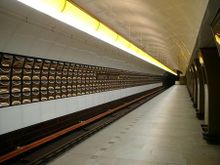
CHEAP TRAVEL EUROPE
AIRPORT INFO & COMPANY
Prague Ruzyně International Airport (Czech: Letiště Praha-Ruzyně, Czech pronunciation: [ˈpraɦa ˈrʊzɪɲɛ], (IATA: PRG, ICAO: LKPR), serves Prague, Czech Republic. Located 10 kilometres (6 mi) west[1] of the city centre, the airport is a hub for Czech Airlines. It was opened on 5 April 1937. Prague-Ruzyně is the biggest airport in the Czech Republic, and with 11.6 million passengers in 2009, the busiest one within the new EU member states. It was named the best airport in Central and Eastern Europe by Skytrax in 2005[2] and 2007.[3]
The Prague Metro is a subway, underground public transportation network in Prague, Czech Republic. It is the fastest means of transportation around the city and serves about one and a half million passengers a day, which makes it the seventh busiest metro system in Europe.
Basic information
The Prague Metro comprises three lines, each of which is represented by its own colour on the maps and signs: Line A (green), Line B (yellow) and Line C (red). There are 57 stations in total (three of which are transfer stations) connected by nearly 60 kilometres of mostly underground railways. The metro service operates between 4-5 am till midnight from Sunday till Thursday (on Friday and Saturday the last trains journey start at 1am), with about two- to three-minute intervals between trains during rush hours. Over 620 million passengers use the Prague Metro every year.
Layout and stations
The Prague Metro system is laid-out as a triangle, with all three lines meeting in the center of the city at three interchange stations. Each interchange station has two halls, one hall for each line. The depth of the stations (and the connecting lines) varies considerably. The deepest station is Náměstí Míru, located 52 meters under the ground. Parts of the tracks in the city center were mostly bored using the tunneling shield. Outer parts were dug by the cut-and-cover method and the stations are only a few meters under the surface. The B line partly runs in a glassed-in tunnel above the ground.
Most stations have a single platform in the center of the station hall (tunnel) serving both directions. The sub-surface stations have a straight ceiling sometimes supported by columns. The deep-level stations are larger tunnels with the track tunnels on each side. The walls of many stations are decorated using colored aluminium panels, each station having its own color.
| # | Name | Opened | Length | Stations |
|---|---|---|---|---|
| A | Line A (Linka A) | 1978 | 11.0 km | 13 |
| B | Line B (Linka B) | 1985 | 25.6 km | 24 |
| C | Line C (Linka C) | 1974 | 22.7 km | 20 |
| Total: | 59.3 km | 57 (transfer stations counted as two; see above) |
Tickets
The Prague Metro is an open ticket system. Passengers must buy and validate a ticket before entering the metro platform. There are uniformed ticket inspectors who have the right to check the validity of the ticket at any time within the compulsory ticket area.
The tickets are the same for all means of transport in Prague (excluding commuter trains for single tickets). The basic single ticket (the transfer variant) costs 26 CZK (as of 1 January 2008) and allows a 75-minute ride (90 minutes during evenings, weekends and state holidays). The non-transferable ticket (costing 18 CZK) is valid for a distance of five metro stations (not including the station of validation) allowing changes between lines A, B and C, but no longer than 30 minutes in total. Since December 2007 SMS purchase for the basic single transfer ticket is possible.
Short-term tourist passes are available for periods of 24 hours (100 CZK), 3 days (330 CZK) and 5 days (500 CZK).
In addition, longer-term season tickets can be bought (photo ID required) for periods of one month (550 CZK), three months (1480 CZK) or the annual pass (4750 CZK).
History
The metro is run by the Prague Public Transit Company Co. Inc. (in Czech officially Dopravní podnik hlavního města Prahy a.s.) which manages all means of public transport around the city (the metro, tramways, buses, the funicular to Petřín Hill and the chairlift inside Prague Zoo). Since 1993, this system has been connected to commuter trains and buses and also to "park-and-ride" parking lots. Together they form a public transportation network reaching further from the city called Prague Integrated Transport (Pražská integrovaná doprava—PID). Whilst the large system is zonally priced, the metro is fully inside the central zone.
Many Prague Metro stations are quite large, with several entrances spaced relatively far apart. This can often lead to confusion for tourists, especially at the central hubs such as Můstek or Muzeum: it is not enough to merely get off at the right station; one must also choose the right way out to the surface, otherwise one can easily find oneself five or ten minutes' walking distance from the required destination. However, in general the stations are well signposted even for those unfamiliar with local language.

